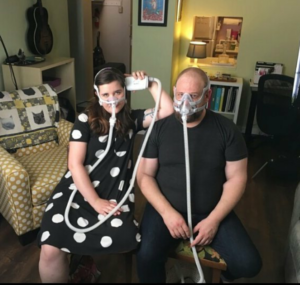A note from Stacy: This post is generously sponsored by CheapCPAPSupplies.com! I am so grateful to have their support in spreading the word about sleep apnea, especially when it comes to supporting women with this condition. Please visit their website for – you guessed it – cheap cpap supplies! They have supplies available for PAPpers with insurance, as well as those who pay out of pocket.
When I was diagnosed with sleep apnea, I was shocked. Me? Sleep apnea? But I don’t even snore!
My knowledge about sleep apnea was limited. In my mind, sleep apnea was a condition that bigger people – usually men – had that made them snore loudly. I had no idea about the serious health implications that sleep apnea brought on.
The person closest to me with sleep apnea was literally the person closest to me – my husband. Though he had a sleep study, he never followed up to get the CPAP machine that was recommended to him. It just didn’t seem important enough to pursue. I felt the same way – it was just snoring, right? I didn’t want him to have one of those annoying machines.
Of course, I am kicking myself for this now! How could I have ever been so ignorant? And how, after all these years with fatigue AND while living with another person with sleep apnea, could I have not figured out that I had it, too?
As it turns out, sleep apnea manifests quite a bit differently in women than it does in men. However, much of the health information presented to the public speaks to symptoms in men and fails to address how women might experience the condition differently.
According to a 2013 UCLA Study, the effect of sleep apnea on women’s hearts is much more pronounced than it is in men. In fact, when asked to do a series of breathing tests, the following was discovered:
“In all three tests, changes to the normal heart rate were lower and delayed in patients with obstructive sleep apnea, compared with healthy controls. The researchers found that the difference was even more pronounced in women.
‘The heart-rate results for these tests show that the impact of sleep apnea, while bad in men, is more severe in women,’ Macey said. ‘This may mean that women are more likely to develop symptoms of heart disease, as well as other consequences of poor adaptation to daily physical tasks. Early detection and treatment may be needed to protect against damage to the brain and other organs.’”
Poor adaptation to daily physical tasks? Check that one off the good old symptom checklist for me.

Dave and I, acting like stars.
A great example of these differences? My husband and I. We could basically be the poster couple for how sleep apnea affects men and women differently. He has always had a normal schedule. He wakes up at a reasonable hour, even when he doesn’t have to work. I don’t think I have seen him tired enough to take a nap more than once or twice in the whole time that we have known each other.
On the other hand, before my diagnosis and subsequent treatment, I was sleeping ALL the time. If I had downtime, I would take a nap. If I didn’t have somewhere to be, I would sleep all day.
According to The National Sleep Foundation, women are often misdiagnosed with conditions such as anemia, depression, fibromyalgia, hypertension, hypochondria and hyperthyroidism.
Again, my husband and I fit this research: my husband, was sent for a sleep study and promptly diagnosed. On the other hand, it took me sixteen years of doctors visits (including, you guessed it, lots of testing for conditions such as anemia, depression and thyroid imbalance) to finally get a sleep study ordered.
So why do I make such a big deal out of this?
Because without proper diagnosis, women are struggling to get the quality of life that they need. And, according to this study from BioMed Research International: “Untreated severe OSA has been independently and significantly associated with cardiovascular death in women.” Yes, more women are dying because of issues related to sleep apnea.
So what can we do to fix it?
First, it is essential for anyone who is worried that they might have sleep apnea to request a sleep study from their doctor as soon as possible. If you do end up with a sleep apnea diagnosis, getting proper treatment right away could save your life.
Second, it’s important to be aware of the symptoms and how they present in differently for different people. Contrary to popular belief, sleep apnea can exist in people of all ages, sexes and body types. And no, snoring is not a requirement. (I don’t snore!)
Finally, if you currently have sleep apnea, it is important that you share your story with others as you feel comfortable. Let people know your symptoms and how you got diagnosed. Not a day goes by that I don’t wish that someone had told me about the male/female differences in sleep apnea back when my chronic fatigue symptoms started at fifteen. Though I am grateful for where I am today, I would have had a much better life in my twenties if my sleep apnea were being treated properly and not just brushed aside by medical providers.
Recognizing the differences in symptoms between men and women is absolutely essential when it comes to moving forward in getting women the diagnoses that they need. Luckily, research on this very topic is starting to become more common and more women are beginning to get the treatment that can help to change their lives.




Thanks for sharing. Just as you, I was surprised when my neurologist referred me to a sleep specialist and I was floored to learn I tested posititve. I stopped breathing twenty times per hour. I wasn’t know for being a snorer either. My daughter told me that I sounded like a cat purring. My husband was diagnosed a couple of years before I was. I love the picture of both you and your husband kitted up in your CPAP gear. I don’t believe my husband would agree to it, so thumbs up to your guy!